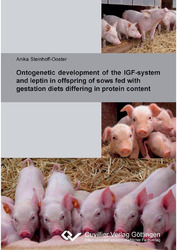| Departments | |
|---|---|
| Book Series (96) |
1378
|
| Nachhaltigkeit |
3
|
| Gesundheitswesen |
1
|
| Humanities |
2363
|
| Natural Sciences |
5406
|
| Mathematics | 229 |
| Informatics | 319 |
| Physics | 980 |
| Chemistry | 1363 |
| Geosciences | 131 |
| Human medicine | 243 |
| Stomatology | 10 |
| Veterinary medicine | 108 |
| Pharmacy | 147 |
| Biology | 835 |
| Biochemistry, molecular biology, gene technology | 121 |
| Biophysics | 25 |
| Domestic and nutritional science | 45 |
| Agricultural science | 1004 |
| Forest science | 201 |
| Horticultural science | 20 |
| Environmental research, ecology and landscape conservation | 148 |
| Engineering |
1791
|
| Common |
98
|
|
Leitlinien Unfallchirurgie
5. Auflage bestellen |
|
Advanced Search
Ontogenetic development of the IGF-system and leptin in offspring of sows fed with gestation diets differing in protein content (English shop)
Anika Steinhoff-Ooster (Author)Preview
Table of Contents, Datei (31 KB)
Extract, Datei (180 KB)
The aim of this dissertation was to characterize leptin and the different components of the IGF-system in offspring of sows fed with different protein contents throughout pregnancy and to ascertain long term consequences caused by an inadequate nutritional environment in utero. German Landrace gilts (n=78) were fed gestation diets (~15.4 MJ ME/kg) of either low (LP, 6%; n=26), adequate (AP, 12%; n=26), or high (HP, 30%; n=24) protein content. For sampling at day 94 of gestation, 26 gilts with their fetuses were investigated. At parturition, the offspring of the remaining 52 gilts were cross fostered to nursing sows fed a standard lactation diet. Fetal and birth weight of all investigated offspring were recorded and classified into 2 different fetal body weight classes (Fbwc ≤ or > 0.65 kg) or birth weight classes (Bbwc ≤ or > 1.3 kg). In addition, the litter size of any gilt was classified into two groups (Lsgr ≤ or > 12 piglets). Blood and liver samples from 306 piglets in total were collected. In detail, fetuses of day 94 of gestation (dpc), and piglets at their 1st, 28th and 188th day of life (dpn) were sampled. Blood samples were assayed for IGF-1, IGF-2 and leptin by ELISA and for IGF binding proteins via a quantitative, non-radioactive Western ligand blotting protocol established and optimized herein. Liver samples were assayed for IGF-1 receptor by use of ELISA. The concentrations of leptin in offspring were not affected by maternal diet over all postnatal days. With the exception of dpn 1, the IGF-1 concentrations remained unchanged in response to maternal dietary treatment. Piglets born to mothers fed the LP diet had decreased IGF-1 concentrations compared to piglets born to HP mothers (P < 0.05). Piglets of lower birth weight also showed lower IGF-1 concentrations; IGF-1 and the body weights on dpn 1 were positively correlated. For IGF-2, an association between its concentration and low fetal body weight was observed. In line with previous studies, nutrient restriction as modulator had more pronounced effects on the circulating IGF-1 concentrations than the ones of IGF-2. The concentrations of the IGFBPs were primarily effected by nutrition in utero at the early stages of development. IGFBP-1 was higher in HP fetuses compared to the other two diet groups on dpc 94. For neonatal piglets, IGF-1 and IGFBP-1 were negatively correlated; piglets from LP fed mothers had higher IGFBP-1 values; they also had lower concentrations of IGF-1 than AP and HP piglets. Piglets born to LP fed mothers had lower IGFBP-2 values on dpn 1 and dpn 28; for IGFBP-3 differences related to maternal feeding group were limited to dpn 1: HP piglets had higher IGFBP-3 concentrations than AP piglets. On none of the sampling days, differences between the diet groups were observed for liver IGF-1 receptor content. Neither maternal feeding group nor fetal body weight nor litter size nor sex apparently influenced IGF-1 receptor content on dpc 94 in liver, indicating that different protein diets in utero throughout the entire pregnancy might rather act at the level of the ligand than of the receptor, if the IGF-system is concerned at all. Nevertheless the results of this study show clearly, that all ascertained effects of modified protein diets during gestation were limited to prenatal and early postnatal life. Significant effects resulted predominantly from protein restriction in utero whereas protein excess exerted no or only few effects on all factors tested. Possibly the inadequate protein supply during gestation could largely be compensated during the suckling period and thereafter when feeding was homogeneous in all groups. The lack of persistent effects by maternal feeding on the endocrine systems indicates adaptive processes; moreover, carcass composition data do not support long lasting effects of subtle early endocrine changes.
| ISBN-13 (Printausgabe) | 3954040611 |
| ISBN-13 (Hard Copy) | 9783954040612 |
| ISBN-13 (eBook) | 9783736940611 |
| Final Book Format | A5 |
| Language | English |
| Page Number | 110 |
| Lamination of Cover | glossy |
| Edition | 1 Aufl. |
| Volume | 0 |
| Publication Place | Göttingen |
| Place of Dissertation | Bonn |
| Publication Date | 2012-03-26 |
| General Categorization | Dissertation |
| Departments |
Agricultural science
|








